BMP4003 Business Environment Exam Paper 2021/22
VerifiedAdded on 2023/06/05
|9
|2824
|210
AI Summary
This is the exam paper for BMP4003 Business Environment for the semester 2 examination 2021/22 of BSc (Hons) Business Management. The paper includes two sections with questions related to fiscal policy, economic growth, interest rates, economic cycle, and the impact of COVID-19 lockdown on the UK economy. The paper also discusses the impact of UK leaving the EU on consumers and businesses of trading internationally.
Contribute Materials
Your contribution can guide someone’s learning journey. Share your
documents today.
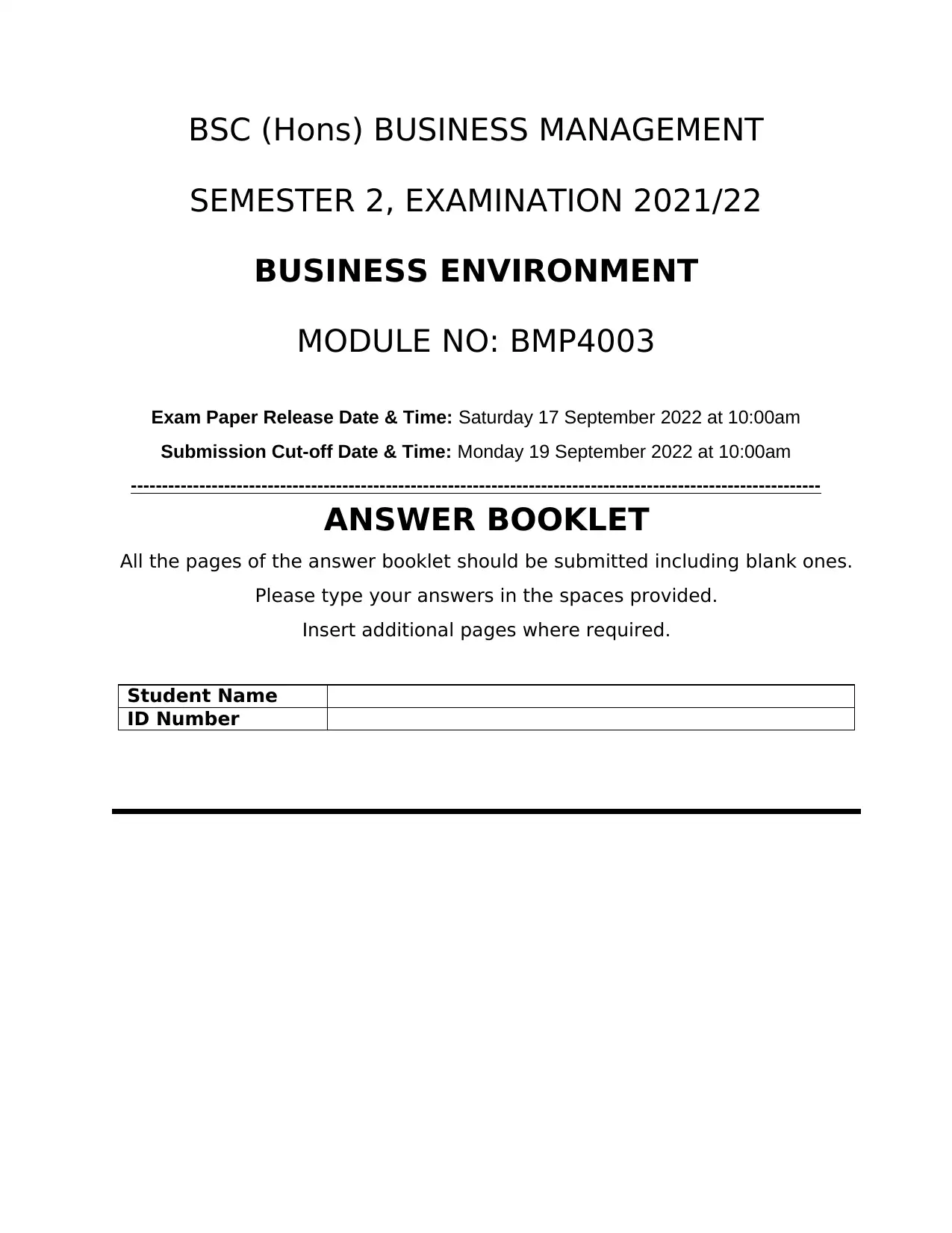
BSC (Hons) BUSINESS MANAGEMENT
SEMESTER 2, EXAMINATION 2021/22
BUSINESS ENVIRONMENT
MODULE NO: BMP4003
Exam Paper Release Date & Time: Saturday 17 September 2022 at 10:00am
Submission Cut-off Date & Time: Monday 19 September 2022 at 10:00am
---------------------------------------------------------------------------------------------------------------
ANSWER BOOKLET
All the pages of the answer booklet should be submitted including blank ones.
Please type your answers in the spaces provided.
Insert additional pages where required.
Student Name
ID Number
SEMESTER 2, EXAMINATION 2021/22
BUSINESS ENVIRONMENT
MODULE NO: BMP4003
Exam Paper Release Date & Time: Saturday 17 September 2022 at 10:00am
Submission Cut-off Date & Time: Monday 19 September 2022 at 10:00am
---------------------------------------------------------------------------------------------------------------
ANSWER BOOKLET
All the pages of the answer booklet should be submitted including blank ones.
Please type your answers in the spaces provided.
Insert additional pages where required.
Student Name
ID Number
Secure Best Marks with AI Grader
Need help grading? Try our AI Grader for instant feedback on your assignments.
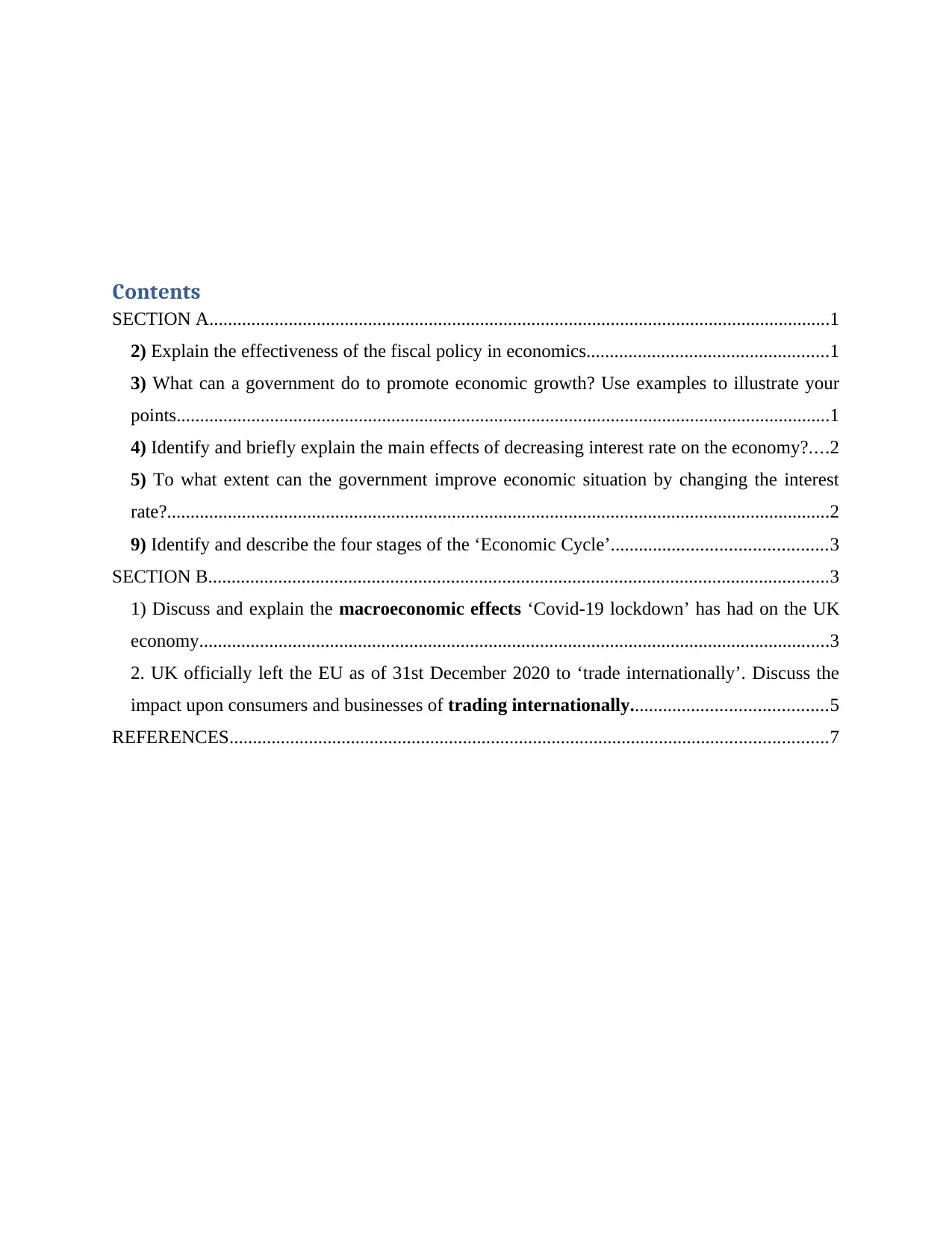
Contents
SECTION A.....................................................................................................................................1
2) Explain the effectiveness of the fiscal policy in economics....................................................1
3) What can a government do to promote economic growth? Use examples to illustrate your
points............................................................................................................................................1
4) Identify and briefly explain the main effects of decreasing interest rate on the economy?....2
5) To what extent can the government improve economic situation by changing the interest
rate?..............................................................................................................................................2
9) Identify and describe the four stages of the ‘Economic Cycle’..............................................3
SECTION B.....................................................................................................................................3
1) Discuss and explain the macroeconomic effects ‘Covid-19 lockdown’ has had on the UK
economy.......................................................................................................................................3
2. UK officially left the EU as of 31st December 2020 to ‘trade internationally’. Discuss the
impact upon consumers and businesses of trading internationally..........................................5
REFERENCES................................................................................................................................7
SECTION A.....................................................................................................................................1
2) Explain the effectiveness of the fiscal policy in economics....................................................1
3) What can a government do to promote economic growth? Use examples to illustrate your
points............................................................................................................................................1
4) Identify and briefly explain the main effects of decreasing interest rate on the economy?....2
5) To what extent can the government improve economic situation by changing the interest
rate?..............................................................................................................................................2
9) Identify and describe the four stages of the ‘Economic Cycle’..............................................3
SECTION B.....................................................................................................................................3
1) Discuss and explain the macroeconomic effects ‘Covid-19 lockdown’ has had on the UK
economy.......................................................................................................................................3
2. UK officially left the EU as of 31st December 2020 to ‘trade internationally’. Discuss the
impact upon consumers and businesses of trading internationally..........................................5
REFERENCES................................................................................................................................7
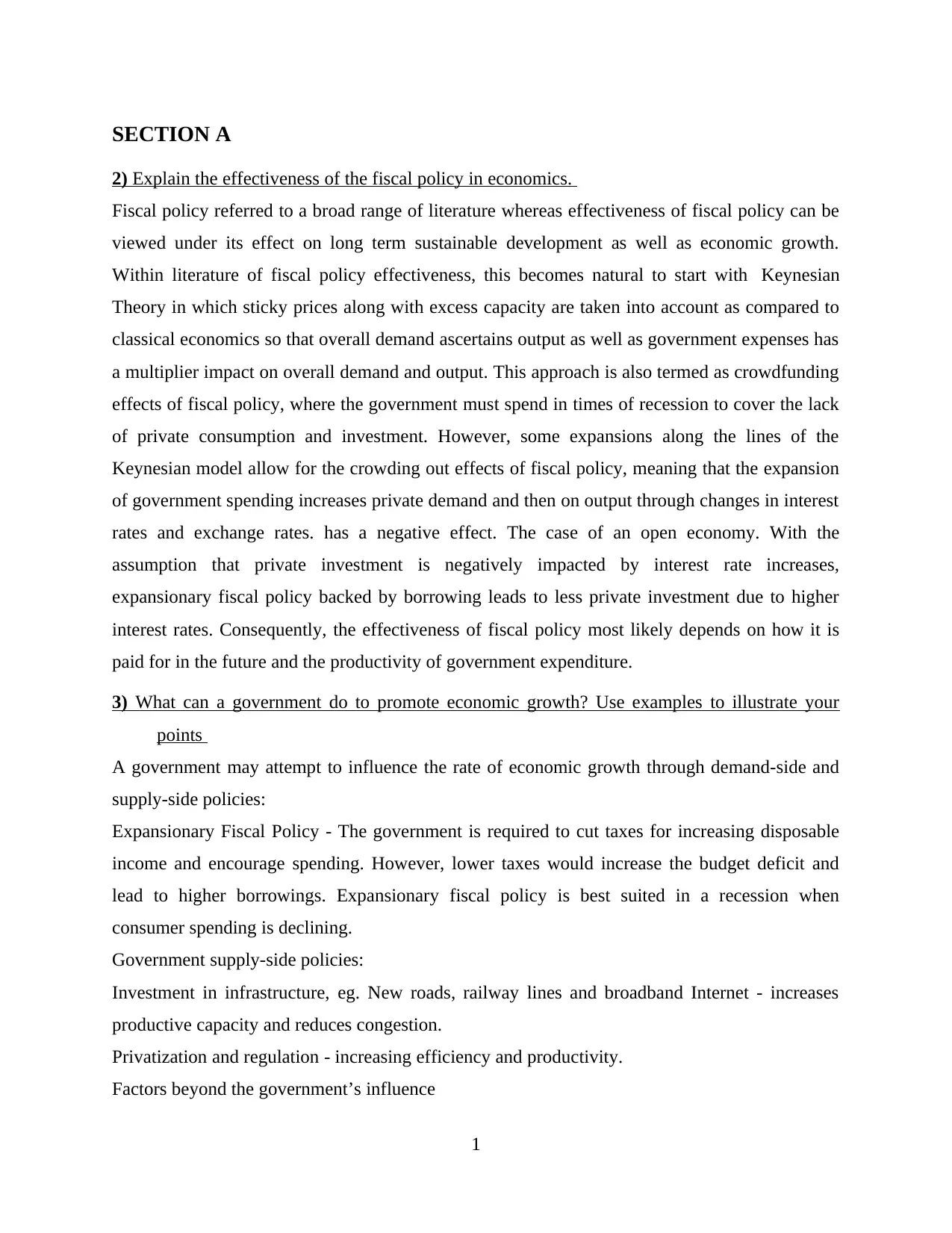
SECTION A
2) Explain the effectiveness of the fiscal policy in economics.
Fiscal policy referred to a broad range of literature whereas effectiveness of fiscal policy can be
viewed under its effect on long term sustainable development as well as economic growth.
Within literature of fiscal policy effectiveness, this becomes natural to start with Keynesian
Theory in which sticky prices along with excess capacity are taken into account as compared to
classical economics so that overall demand ascertains output as well as government expenses has
a multiplier impact on overall demand and output. This approach is also termed as crowdfunding
effects of fiscal policy, where the government must spend in times of recession to cover the lack
of private consumption and investment. However, some expansions along the lines of the
Keynesian model allow for the crowding out effects of fiscal policy, meaning that the expansion
of government spending increases private demand and then on output through changes in interest
rates and exchange rates. has a negative effect. The case of an open economy. With the
assumption that private investment is negatively impacted by interest rate increases,
expansionary fiscal policy backed by borrowing leads to less private investment due to higher
interest rates. Consequently, the effectiveness of fiscal policy most likely depends on how it is
paid for in the future and the productivity of government expenditure.
3) What can a government do to promote economic growth? Use examples to illustrate your
points
A government may attempt to influence the rate of economic growth through demand-side and
supply-side policies:
Expansionary Fiscal Policy - The government is required to cut taxes for increasing disposable
income and encourage spending. However, lower taxes would increase the budget deficit and
lead to higher borrowings. Expansionary fiscal policy is best suited in a recession when
consumer spending is declining.
Government supply-side policies:
Investment in infrastructure, eg. New roads, railway lines and broadband Internet - increases
productive capacity and reduces congestion.
Privatization and regulation - increasing efficiency and productivity.
Factors beyond the government’s influence
1
2) Explain the effectiveness of the fiscal policy in economics.
Fiscal policy referred to a broad range of literature whereas effectiveness of fiscal policy can be
viewed under its effect on long term sustainable development as well as economic growth.
Within literature of fiscal policy effectiveness, this becomes natural to start with Keynesian
Theory in which sticky prices along with excess capacity are taken into account as compared to
classical economics so that overall demand ascertains output as well as government expenses has
a multiplier impact on overall demand and output. This approach is also termed as crowdfunding
effects of fiscal policy, where the government must spend in times of recession to cover the lack
of private consumption and investment. However, some expansions along the lines of the
Keynesian model allow for the crowding out effects of fiscal policy, meaning that the expansion
of government spending increases private demand and then on output through changes in interest
rates and exchange rates. has a negative effect. The case of an open economy. With the
assumption that private investment is negatively impacted by interest rate increases,
expansionary fiscal policy backed by borrowing leads to less private investment due to higher
interest rates. Consequently, the effectiveness of fiscal policy most likely depends on how it is
paid for in the future and the productivity of government expenditure.
3) What can a government do to promote economic growth? Use examples to illustrate your
points
A government may attempt to influence the rate of economic growth through demand-side and
supply-side policies:
Expansionary Fiscal Policy - The government is required to cut taxes for increasing disposable
income and encourage spending. However, lower taxes would increase the budget deficit and
lead to higher borrowings. Expansionary fiscal policy is best suited in a recession when
consumer spending is declining.
Government supply-side policies:
Investment in infrastructure, eg. New roads, railway lines and broadband Internet - increases
productive capacity and reduces congestion.
Privatization and regulation - increasing efficiency and productivity.
Factors beyond the government’s influence
1
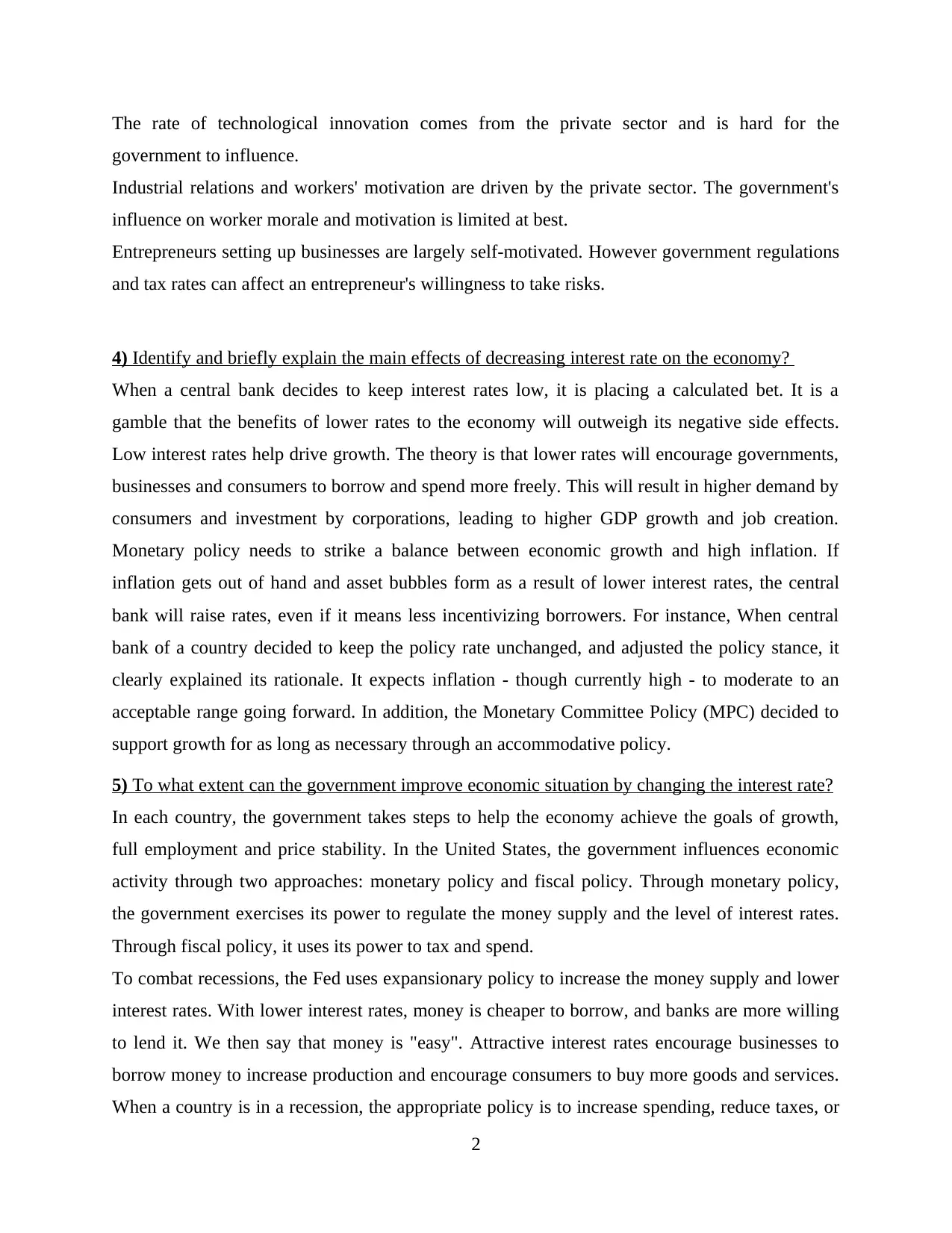
The rate of technological innovation comes from the private sector and is hard for the
government to influence.
Industrial relations and workers' motivation are driven by the private sector. The government's
influence on worker morale and motivation is limited at best.
Entrepreneurs setting up businesses are largely self-motivated. However government regulations
and tax rates can affect an entrepreneur's willingness to take risks.
4) Identify and briefly explain the main effects of decreasing interest rate on the economy?
When a central bank decides to keep interest rates low, it is placing a calculated bet. It is a
gamble that the benefits of lower rates to the economy will outweigh its negative side effects.
Low interest rates help drive growth. The theory is that lower rates will encourage governments,
businesses and consumers to borrow and spend more freely. This will result in higher demand by
consumers and investment by corporations, leading to higher GDP growth and job creation.
Monetary policy needs to strike a balance between economic growth and high inflation. If
inflation gets out of hand and asset bubbles form as a result of lower interest rates, the central
bank will raise rates, even if it means less incentivizing borrowers. For instance, When central
bank of a country decided to keep the policy rate unchanged, and adjusted the policy stance, it
clearly explained its rationale. It expects inflation - though currently high - to moderate to an
acceptable range going forward. In addition, the Monetary Committee Policy (MPC) decided to
support growth for as long as necessary through an accommodative policy.
5) To what extent can the government improve economic situation by changing the interest rate?
In each country, the government takes steps to help the economy achieve the goals of growth,
full employment and price stability. In the United States, the government influences economic
activity through two approaches: monetary policy and fiscal policy. Through monetary policy,
the government exercises its power to regulate the money supply and the level of interest rates.
Through fiscal policy, it uses its power to tax and spend.
To combat recessions, the Fed uses expansionary policy to increase the money supply and lower
interest rates. With lower interest rates, money is cheaper to borrow, and banks are more willing
to lend it. We then say that money is "easy". Attractive interest rates encourage businesses to
borrow money to increase production and encourage consumers to buy more goods and services.
When a country is in a recession, the appropriate policy is to increase spending, reduce taxes, or
2
government to influence.
Industrial relations and workers' motivation are driven by the private sector. The government's
influence on worker morale and motivation is limited at best.
Entrepreneurs setting up businesses are largely self-motivated. However government regulations
and tax rates can affect an entrepreneur's willingness to take risks.
4) Identify and briefly explain the main effects of decreasing interest rate on the economy?
When a central bank decides to keep interest rates low, it is placing a calculated bet. It is a
gamble that the benefits of lower rates to the economy will outweigh its negative side effects.
Low interest rates help drive growth. The theory is that lower rates will encourage governments,
businesses and consumers to borrow and spend more freely. This will result in higher demand by
consumers and investment by corporations, leading to higher GDP growth and job creation.
Monetary policy needs to strike a balance between economic growth and high inflation. If
inflation gets out of hand and asset bubbles form as a result of lower interest rates, the central
bank will raise rates, even if it means less incentivizing borrowers. For instance, When central
bank of a country decided to keep the policy rate unchanged, and adjusted the policy stance, it
clearly explained its rationale. It expects inflation - though currently high - to moderate to an
acceptable range going forward. In addition, the Monetary Committee Policy (MPC) decided to
support growth for as long as necessary through an accommodative policy.
5) To what extent can the government improve economic situation by changing the interest rate?
In each country, the government takes steps to help the economy achieve the goals of growth,
full employment and price stability. In the United States, the government influences economic
activity through two approaches: monetary policy and fiscal policy. Through monetary policy,
the government exercises its power to regulate the money supply and the level of interest rates.
Through fiscal policy, it uses its power to tax and spend.
To combat recessions, the Fed uses expansionary policy to increase the money supply and lower
interest rates. With lower interest rates, money is cheaper to borrow, and banks are more willing
to lend it. We then say that money is "easy". Attractive interest rates encourage businesses to
borrow money to increase production and encourage consumers to buy more goods and services.
When a country is in a recession, the appropriate policy is to increase spending, reduce taxes, or
2
Secure Best Marks with AI Grader
Need help grading? Try our AI Grader for instant feedback on your assignments.
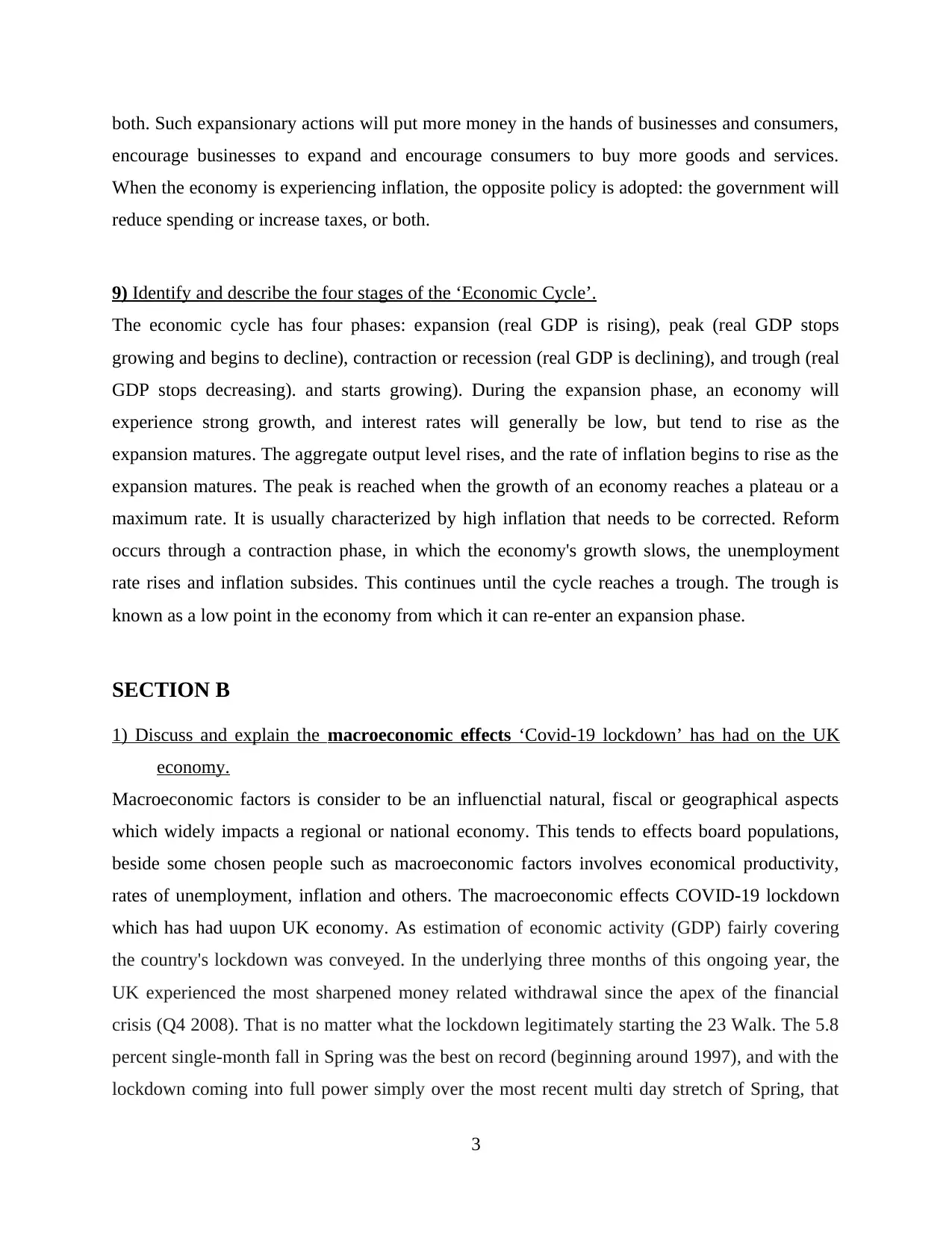
both. Such expansionary actions will put more money in the hands of businesses and consumers,
encourage businesses to expand and encourage consumers to buy more goods and services.
When the economy is experiencing inflation, the opposite policy is adopted: the government will
reduce spending or increase taxes, or both.
9) Identify and describe the four stages of the ‘Economic Cycle’.
The economic cycle has four phases: expansion (real GDP is rising), peak (real GDP stops
growing and begins to decline), contraction or recession (real GDP is declining), and trough (real
GDP stops decreasing). and starts growing). During the expansion phase, an economy will
experience strong growth, and interest rates will generally be low, but tend to rise as the
expansion matures. The aggregate output level rises, and the rate of inflation begins to rise as the
expansion matures. The peak is reached when the growth of an economy reaches a plateau or a
maximum rate. It is usually characterized by high inflation that needs to be corrected. Reform
occurs through a contraction phase, in which the economy's growth slows, the unemployment
rate rises and inflation subsides. This continues until the cycle reaches a trough. The trough is
known as a low point in the economy from which it can re-enter an expansion phase.
SECTION B
1) Discuss and explain the macroeconomic effects ‘Covid-19 lockdown’ has had on the UK
economy.
Macroeconomic factors is consider to be an influenctial natural, fiscal or geographical aspects
which widely impacts a regional or national economy. This tends to effects board populations,
beside some chosen people such as macroeconomic factors involves economical productivity,
rates of unemployment, inflation and others. The macroeconomic effects COVID-19 lockdown
which has had uupon UK economy. As estimation of economic activity (GDP) fairly covering
the country's lockdown was conveyed. In the underlying three months of this ongoing year, the
UK experienced the most sharpened money related withdrawal since the apex of the financial
crisis (Q4 2008). That is no matter what the lockdown legitimately starting the 23 Walk. The 5.8
percent single-month fall in Spring was the best on record (beginning around 1997), and with the
lockdown coming into full power simply over the most recent multi day stretch of Spring, that
3
encourage businesses to expand and encourage consumers to buy more goods and services.
When the economy is experiencing inflation, the opposite policy is adopted: the government will
reduce spending or increase taxes, or both.
9) Identify and describe the four stages of the ‘Economic Cycle’.
The economic cycle has four phases: expansion (real GDP is rising), peak (real GDP stops
growing and begins to decline), contraction or recession (real GDP is declining), and trough (real
GDP stops decreasing). and starts growing). During the expansion phase, an economy will
experience strong growth, and interest rates will generally be low, but tend to rise as the
expansion matures. The aggregate output level rises, and the rate of inflation begins to rise as the
expansion matures. The peak is reached when the growth of an economy reaches a plateau or a
maximum rate. It is usually characterized by high inflation that needs to be corrected. Reform
occurs through a contraction phase, in which the economy's growth slows, the unemployment
rate rises and inflation subsides. This continues until the cycle reaches a trough. The trough is
known as a low point in the economy from which it can re-enter an expansion phase.
SECTION B
1) Discuss and explain the macroeconomic effects ‘Covid-19 lockdown’ has had on the UK
economy.
Macroeconomic factors is consider to be an influenctial natural, fiscal or geographical aspects
which widely impacts a regional or national economy. This tends to effects board populations,
beside some chosen people such as macroeconomic factors involves economical productivity,
rates of unemployment, inflation and others. The macroeconomic effects COVID-19 lockdown
which has had uupon UK economy. As estimation of economic activity (GDP) fairly covering
the country's lockdown was conveyed. In the underlying three months of this ongoing year, the
UK experienced the most sharpened money related withdrawal since the apex of the financial
crisis (Q4 2008). That is no matter what the lockdown legitimately starting the 23 Walk. The 5.8
percent single-month fall in Spring was the best on record (beginning around 1997), and with the
lockdown coming into full power simply over the most recent multi day stretch of Spring, that
3
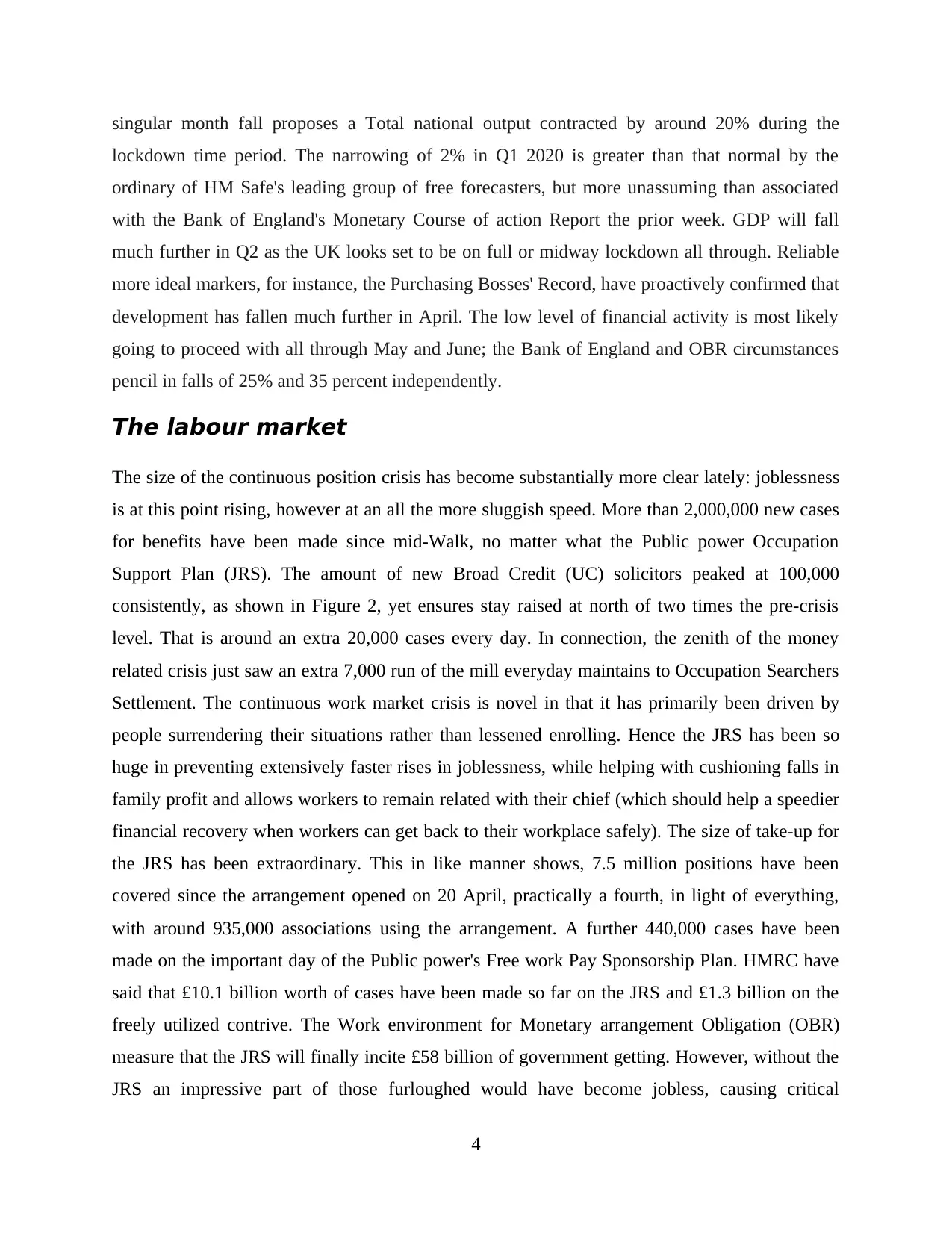
singular month fall proposes a Total national output contracted by around 20% during the
lockdown time period. The narrowing of 2% in Q1 2020 is greater than that normal by the
ordinary of HM Safe's leading group of free forecasters, but more unassuming than associated
with the Bank of England's Monetary Course of action Report the prior week. GDP will fall
much further in Q2 as the UK looks set to be on full or midway lockdown all through. Reliable
more ideal markers, for instance, the Purchasing Bosses' Record, have proactively confirmed that
development has fallen much further in April. The low level of financial activity is most likely
going to proceed with all through May and June; the Bank of England and OBR circumstances
pencil in falls of 25% and 35 percent independently.
The labour market
The size of the continuous position crisis has become substantially more clear lately: joblessness
is at this point rising, however at an all the more sluggish speed. More than 2,000,000 new cases
for benefits have been made since mid-Walk, no matter what the Public power Occupation
Support Plan (JRS). The amount of new Broad Credit (UC) solicitors peaked at 100,000
consistently, as shown in Figure 2, yet ensures stay raised at north of two times the pre-crisis
level. That is around an extra 20,000 cases every day. In connection, the zenith of the money
related crisis just saw an extra 7,000 run of the mill everyday maintains to Occupation Searchers
Settlement. The continuous work market crisis is novel in that it has primarily been driven by
people surrendering their situations rather than lessened enrolling. Hence the JRS has been so
huge in preventing extensively faster rises in joblessness, while helping with cushioning falls in
family profit and allows workers to remain related with their chief (which should help a speedier
financial recovery when workers can get back to their workplace safely). The size of take-up for
the JRS has been extraordinary. This in like manner shows, 7.5 million positions have been
covered since the arrangement opened on 20 April, practically a fourth, in light of everything,
with around 935,000 associations using the arrangement. A further 440,000 cases have been
made on the important day of the Public power's Free work Pay Sponsorship Plan. HMRC have
said that £10.1 billion worth of cases have been made so far on the JRS and £1.3 billion on the
freely utilized contrive. The Work environment for Monetary arrangement Obligation (OBR)
measure that the JRS will finally incite £58 billion of government getting. However, without the
JRS an impressive part of those furloughed would have become jobless, causing critical
4
lockdown time period. The narrowing of 2% in Q1 2020 is greater than that normal by the
ordinary of HM Safe's leading group of free forecasters, but more unassuming than associated
with the Bank of England's Monetary Course of action Report the prior week. GDP will fall
much further in Q2 as the UK looks set to be on full or midway lockdown all through. Reliable
more ideal markers, for instance, the Purchasing Bosses' Record, have proactively confirmed that
development has fallen much further in April. The low level of financial activity is most likely
going to proceed with all through May and June; the Bank of England and OBR circumstances
pencil in falls of 25% and 35 percent independently.
The labour market
The size of the continuous position crisis has become substantially more clear lately: joblessness
is at this point rising, however at an all the more sluggish speed. More than 2,000,000 new cases
for benefits have been made since mid-Walk, no matter what the Public power Occupation
Support Plan (JRS). The amount of new Broad Credit (UC) solicitors peaked at 100,000
consistently, as shown in Figure 2, yet ensures stay raised at north of two times the pre-crisis
level. That is around an extra 20,000 cases every day. In connection, the zenith of the money
related crisis just saw an extra 7,000 run of the mill everyday maintains to Occupation Searchers
Settlement. The continuous work market crisis is novel in that it has primarily been driven by
people surrendering their situations rather than lessened enrolling. Hence the JRS has been so
huge in preventing extensively faster rises in joblessness, while helping with cushioning falls in
family profit and allows workers to remain related with their chief (which should help a speedier
financial recovery when workers can get back to their workplace safely). The size of take-up for
the JRS has been extraordinary. This in like manner shows, 7.5 million positions have been
covered since the arrangement opened on 20 April, practically a fourth, in light of everything,
with around 935,000 associations using the arrangement. A further 440,000 cases have been
made on the important day of the Public power's Free work Pay Sponsorship Plan. HMRC have
said that £10.1 billion worth of cases have been made so far on the JRS and £1.3 billion on the
freely utilized contrive. The Work environment for Monetary arrangement Obligation (OBR)
measure that the JRS will finally incite £58 billion of government getting. However, without the
JRS an impressive part of those furloughed would have become jobless, causing critical
4
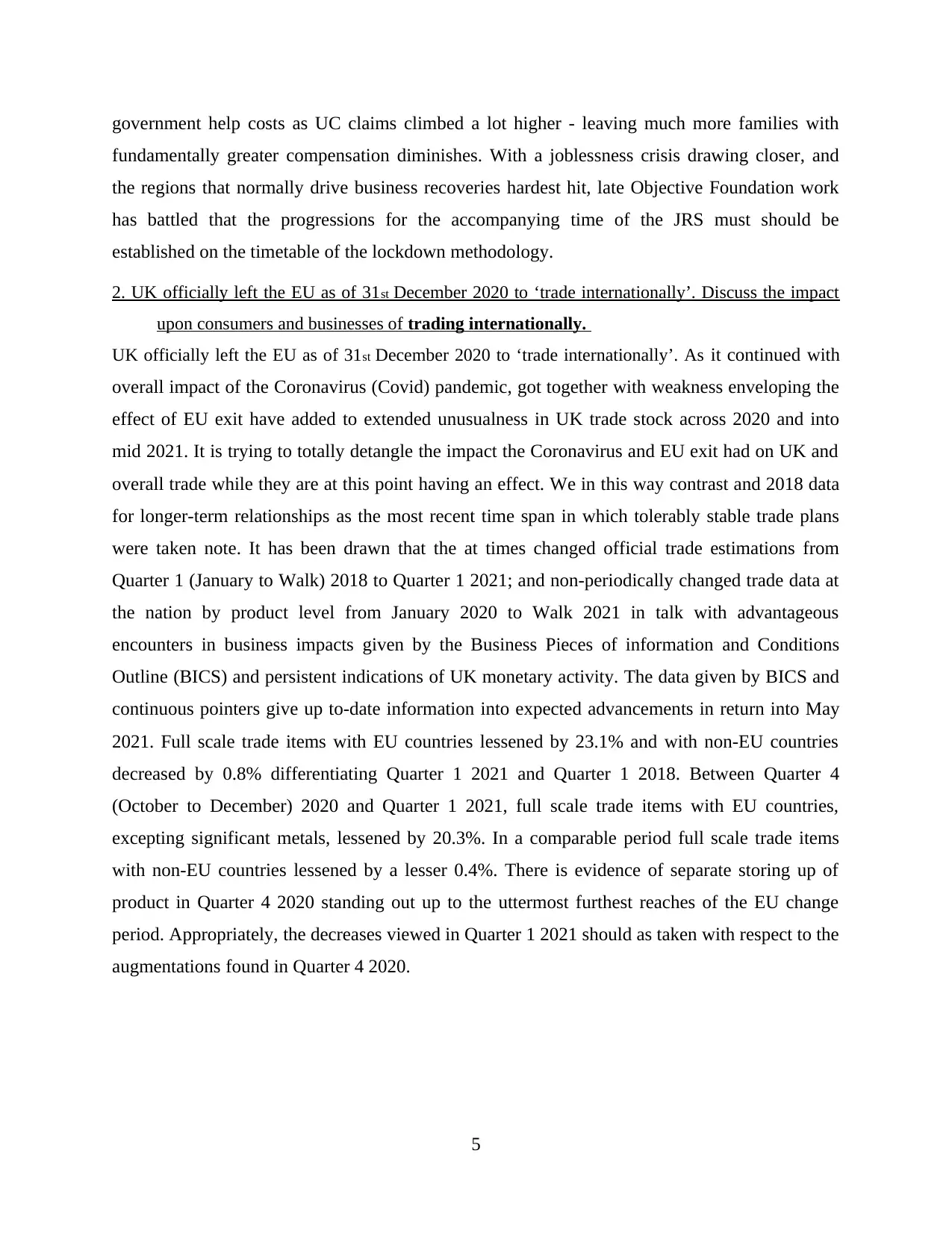
government help costs as UC claims climbed a lot higher - leaving much more families with
fundamentally greater compensation diminishes. With a joblessness crisis drawing closer, and
the regions that normally drive business recoveries hardest hit, late Objective Foundation work
has battled that the progressions for the accompanying time of the JRS must should be
established on the timetable of the lockdown methodology.
2. UK officially left the EU as of 31st December 2020 to ‘trade internationally’. Discuss the impact
upon consumers and businesses of trading internationally.
UK officially left the EU as of 31st December 2020 to ‘trade internationally’. As it continued with
overall impact of the Coronavirus (Covid) pandemic, got together with weakness enveloping the
effect of EU exit have added to extended unusualness in UK trade stock across 2020 and into
mid 2021. It is trying to totally detangle the impact the Coronavirus and EU exit had on UK and
overall trade while they are at this point having an effect. We in this way contrast and 2018 data
for longer-term relationships as the most recent time span in which tolerably stable trade plans
were taken note. It has been drawn that the at times changed official trade estimations from
Quarter 1 (January to Walk) 2018 to Quarter 1 2021; and non-periodically changed trade data at
the nation by product level from January 2020 to Walk 2021 in talk with advantageous
encounters in business impacts given by the Business Pieces of information and Conditions
Outline (BICS) and persistent indications of UK monetary activity. The data given by BICS and
continuous pointers give up to-date information into expected advancements in return into May
2021. Full scale trade items with EU countries lessened by 23.1% and with non-EU countries
decreased by 0.8% differentiating Quarter 1 2021 and Quarter 1 2018. Between Quarter 4
(October to December) 2020 and Quarter 1 2021, full scale trade items with EU countries,
excepting significant metals, lessened by 20.3%. In a comparable period full scale trade items
with non-EU countries lessened by a lesser 0.4%. There is evidence of separate storing up of
product in Quarter 4 2020 standing out up to the uttermost furthest reaches of the EU change
period. Appropriately, the decreases viewed in Quarter 1 2021 should as taken with respect to the
augmentations found in Quarter 4 2020.
5
fundamentally greater compensation diminishes. With a joblessness crisis drawing closer, and
the regions that normally drive business recoveries hardest hit, late Objective Foundation work
has battled that the progressions for the accompanying time of the JRS must should be
established on the timetable of the lockdown methodology.
2. UK officially left the EU as of 31st December 2020 to ‘trade internationally’. Discuss the impact
upon consumers and businesses of trading internationally.
UK officially left the EU as of 31st December 2020 to ‘trade internationally’. As it continued with
overall impact of the Coronavirus (Covid) pandemic, got together with weakness enveloping the
effect of EU exit have added to extended unusualness in UK trade stock across 2020 and into
mid 2021. It is trying to totally detangle the impact the Coronavirus and EU exit had on UK and
overall trade while they are at this point having an effect. We in this way contrast and 2018 data
for longer-term relationships as the most recent time span in which tolerably stable trade plans
were taken note. It has been drawn that the at times changed official trade estimations from
Quarter 1 (January to Walk) 2018 to Quarter 1 2021; and non-periodically changed trade data at
the nation by product level from January 2020 to Walk 2021 in talk with advantageous
encounters in business impacts given by the Business Pieces of information and Conditions
Outline (BICS) and persistent indications of UK monetary activity. The data given by BICS and
continuous pointers give up to-date information into expected advancements in return into May
2021. Full scale trade items with EU countries lessened by 23.1% and with non-EU countries
decreased by 0.8% differentiating Quarter 1 2021 and Quarter 1 2018. Between Quarter 4
(October to December) 2020 and Quarter 1 2021, full scale trade items with EU countries,
excepting significant metals, lessened by 20.3%. In a comparable period full scale trade items
with non-EU countries lessened by a lesser 0.4%. There is evidence of separate storing up of
product in Quarter 4 2020 standing out up to the uttermost furthest reaches of the EU change
period. Appropriately, the decreases viewed in Quarter 1 2021 should as taken with respect to the
augmentations found in Quarter 4 2020.
5
Paraphrase This Document
Need a fresh take? Get an instant paraphrase of this document with our AI Paraphraser
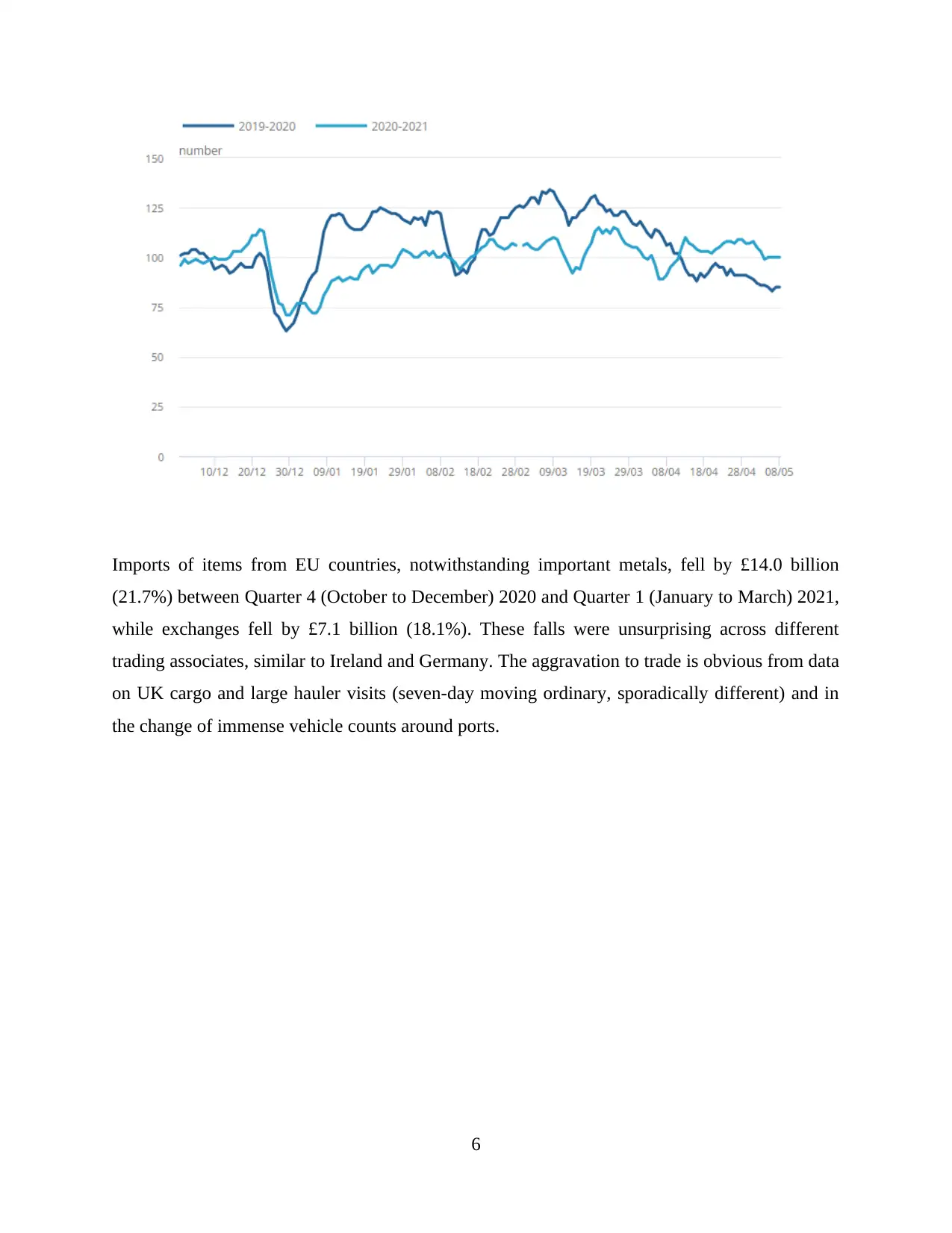
Imports of items from EU countries, notwithstanding important metals, fell by £14.0 billion
(21.7%) between Quarter 4 (October to December) 2020 and Quarter 1 (January to March) 2021,
while exchanges fell by £7.1 billion (18.1%). These falls were unsurprising across different
trading associates, similar to Ireland and Germany. The aggravation to trade is obvious from data
on UK cargo and large hauler visits (seven-day moving ordinary, sporadically different) and in
the change of immense vehicle counts around ports.
6
(21.7%) between Quarter 4 (October to December) 2020 and Quarter 1 (January to March) 2021,
while exchanges fell by £7.1 billion (18.1%). These falls were unsurprising across different
trading associates, similar to Ireland and Germany. The aggravation to trade is obvious from data
on UK cargo and large hauler visits (seven-day moving ordinary, sporadically different) and in
the change of immense vehicle counts around ports.
6
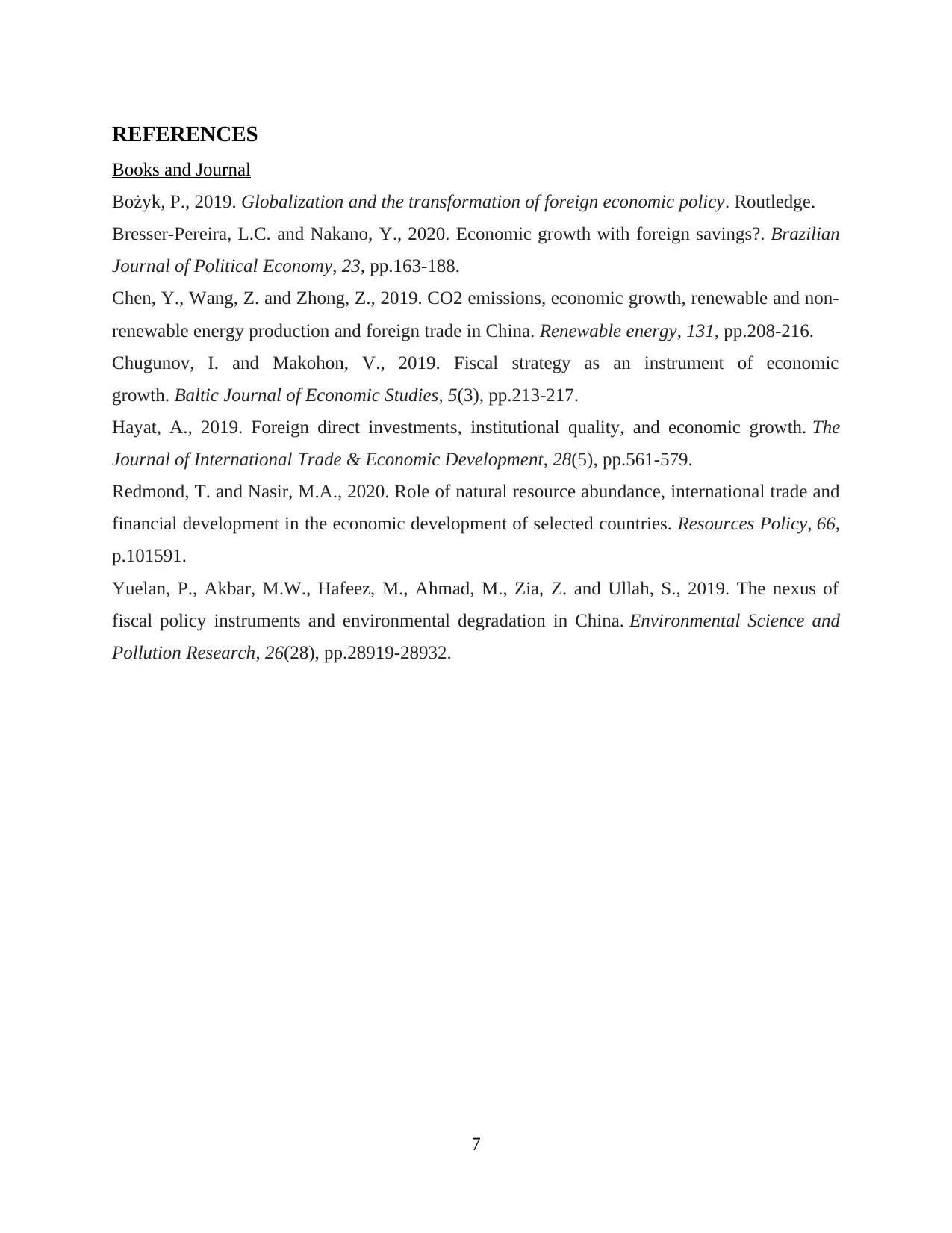
REFERENCES
Books and Journal
Bożyk, P., 2019. Globalization and the transformation of foreign economic policy. Routledge.
Bresser-Pereira, L.C. and Nakano, Y., 2020. Economic growth with foreign savings?. Brazilian
Journal of Political Economy, 23, pp.163-188.
Chen, Y., Wang, Z. and Zhong, Z., 2019. CO2 emissions, economic growth, renewable and non-
renewable energy production and foreign trade in China. Renewable energy, 131, pp.208-216.
Chugunov, I. and Makohon, V., 2019. Fiscal strategy as an instrument of economic
growth. Baltic Journal of Economic Studies, 5(3), pp.213-217.
Hayat, A., 2019. Foreign direct investments, institutional quality, and economic growth. The
Journal of International Trade & Economic Development, 28(5), pp.561-579.
Redmond, T. and Nasir, M.A., 2020. Role of natural resource abundance, international trade and
financial development in the economic development of selected countries. Resources Policy, 66,
p.101591.
Yuelan, P., Akbar, M.W., Hafeez, M., Ahmad, M., Zia, Z. and Ullah, S., 2019. The nexus of
fiscal policy instruments and environmental degradation in China. Environmental Science and
Pollution Research, 26(28), pp.28919-28932.
7
Books and Journal
Bożyk, P., 2019. Globalization and the transformation of foreign economic policy. Routledge.
Bresser-Pereira, L.C. and Nakano, Y., 2020. Economic growth with foreign savings?. Brazilian
Journal of Political Economy, 23, pp.163-188.
Chen, Y., Wang, Z. and Zhong, Z., 2019. CO2 emissions, economic growth, renewable and non-
renewable energy production and foreign trade in China. Renewable energy, 131, pp.208-216.
Chugunov, I. and Makohon, V., 2019. Fiscal strategy as an instrument of economic
growth. Baltic Journal of Economic Studies, 5(3), pp.213-217.
Hayat, A., 2019. Foreign direct investments, institutional quality, and economic growth. The
Journal of International Trade & Economic Development, 28(5), pp.561-579.
Redmond, T. and Nasir, M.A., 2020. Role of natural resource abundance, international trade and
financial development in the economic development of selected countries. Resources Policy, 66,
p.101591.
Yuelan, P., Akbar, M.W., Hafeez, M., Ahmad, M., Zia, Z. and Ullah, S., 2019. The nexus of
fiscal policy instruments and environmental degradation in China. Environmental Science and
Pollution Research, 26(28), pp.28919-28932.
7
1 out of 9
Related Documents
Your All-in-One AI-Powered Toolkit for Academic Success.
+13062052269
info@desklib.com
Available 24*7 on WhatsApp / Email
![[object Object]](/_next/static/media/star-bottom.7253800d.svg)
Unlock your academic potential
© 2024 | Zucol Services PVT LTD | All rights reserved.
